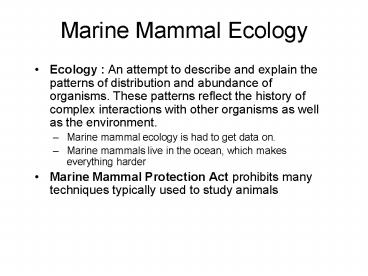Marine Mammal Ecology - PowerPoint PPT Presentation
1 / 19
Title:
Marine Mammal Ecology
Description:
These patterns reflect the history of complex interactions with ... afferent arteriole. Fig. 42-7, p.744. glomerular capillaries. proximal tubule. distal tubule ... – PowerPoint PPT presentation
Number of Views:34
Avg rating:3.0/5.0
Title: Marine Mammal Ecology
1
Marine Mammal Ecology
- Ecology An attempt to describe and explain the
patterns of distribution and abundance of
organisms. These patterns reflect the history of
complex interactions with other organisms as well
as the environment. - Marine mammal ecology is had to get data on.
- Marine mammals live in the ocean, which makes
everything harder - Marine Mammal Protection Act prohibits many
techniques typically used to study animals
2
Marine Mammal Physiology
- Constraints of a Marine Existence
- Breath-Holding (Apnea) for Diving
- Marine Mammals are good divers
- Sperm whale can stay under for gt2hrs diving
1000-2000m - Hooded seals exceed 1000m, staying under for
gt50min
3
Asphyxia
- Asphyxia The combined effects of lack of oxygen
(hypoxia), increased carbon dioxide, and the
accumulation of the products of anaerobic
metabolism, such as lactic acid and hydrogen ions - Aerobic metabolism sustains the brief dives as
well as the first parts of the deeper dives, but
in longer dives it switches to anaerobic
metabolism.
4
Diving Adaptations
- Oxygen storage
- Relative to body size, marine mammal lung
capacities are not much greater than terrestrial
mammals. - Oxygen storage is increased in the blood and
muscles and they have more blood than terrestrial
mammals. - The oxygen storage potential in blood and tissue
is correlated with the diving abilities of the
animal.
5
Diving Adaptations
- Diving Bradycardia (Decreased Heart Rate)
- Low heart rates (5 of predive rate) have been
recorded in phocids - Dolphins can reduce their heart rates from 100 to
12 beats/min.
6
Diving Adaptations
- Preferential distribution of oxygen to various
body tissues during apnea. - Mammalian Diving Response Regional
vasoconstrictuion within those organs that
tolerate a prolonged lack of oxygen. This
selective ischemia (when tissues are deprived of
circulating blood) lowers the metabolism of those
tissues are reduces asphyxia. - Blood is drawn from areas of less importance to
areas of greater importance. - Sufficient blood pressure is maintained for
perfusion of the vital organs, brain and heart.
7
Under Pressure
- Pressure increases by 1 atmosphere for every 10m
of depth - Therefore, the weddell and elephant seals
regularly experience 50 to 100 atmospheres of
pressure.
8
Adaptations to Pressure
- Barotrauma-damage caused by rapid expansion or
squeezing of gas spaces that exceeds the
structural integrity of tissues. - Lung Squeeze- when the tissues deform to the
point of stress. Limits human breathing dives to
about 30m. - Deep diving marine mammals have flexible chest
walls and other structures capable of sufficient
collapse to render the lungs airless. - This keeps air from coming in contact with
tissues at high pressures and thus removes the
possibility of the Bends, Nitrogen Narcosis,
Oxygen Toxicity and Hypoxia.
9
Water and Salt Balance
- Osmosis The movement of water and salt across a
permeable membrane due to a differential in
concentration across that membrane. - If you have a body of high salt concentration
(and therefore low water concentration) sitting
in an environment of lower salt concentrations
(and therefore high water concentration), water
will flow into the body and salt will flow into
the environment. - The reverse also occurs.
- Can result in dessication (losing too much
water), or plasmolysis (the rupturing of cells
that get filled with water).
10
water molecules
protein molecules
semipermeable membrane between two compartments
Fig. 5-12, p.84
11
2 sucrose solution
1 liter of 10 sucrose solution
1 liter of 2 sucrose solution
1 liter of distilled water
Hypotonic Conditions
Hypertonic Conditions
Isotonic Conditions
Fig. 5-13, p.85
12
first compartment
second compartment
hypertonic solution
hypotonic solution
membrane permeable to water but not to solutions
fluid volume rises in second compartment
Fig. 5-14, p.85
13
water gain by osmosis
does not drink water
solutes pumped in by cells in gills
water loss in large volume of dilute urine
Freshwater bony fish (body fluids far saltier
than surroundings)
Fig. 42-3a, p.740
14
water loss by osmosis
drinks seawater
water loss in very small volume of urine
solutes pumped out by cells in gills
Marine bony fish (body fluids less salty than
surroundings)
Fig. 42-3b, p.740
15
Osmolality
- Osmolality (osmotic potential) of sea water is
about 1000 mOsm/kg. For humans, its about 290 to
300 mOsm/kg and for seals it is about 330mOsm/kg - In order make up the difference marine mammals
remove excess salts in very salty uring (2000 to
4000 mOsm/kg) - Kidneys
- Primary site of water conservation as well as
electrolytes and other substances necessary for
life - Marine mammals have very large kidneys, that
receives a lot of metabolic energy.
16
kidney cortex
kidney medulla
renal artery
renal vein
renal pelvis
renal capsule
ureter
Fig. 42-5c, p.742
17
Bowmans capsule (red)
proximal tubule (orange)
distal tubule (brown)
KIDNEY CORTEX
KIDNEY MEDULLA
loop of Henle (yellow)
collecting duct (tan)
Fig. 42-6a, p.743
18
efferent arteriole
afferent arteriole
glomerular capillaries inside Bowmans capsule
peritubular capillaries threading around tubular
nephron regions
Fig. 42-6b, p.743
19
a) Filtration
b) Tubular Reabsorption
proximal tubule
distal tubule
glomerular capillaries
c) Tubular Secretion
CORTEX
MEDULLA
peritubular capillaries
loop of Henle
increasing solute concentration
d) Urine
urine outflow from collecting duct into renal
pelvis
Fig. 42-7, p.744































